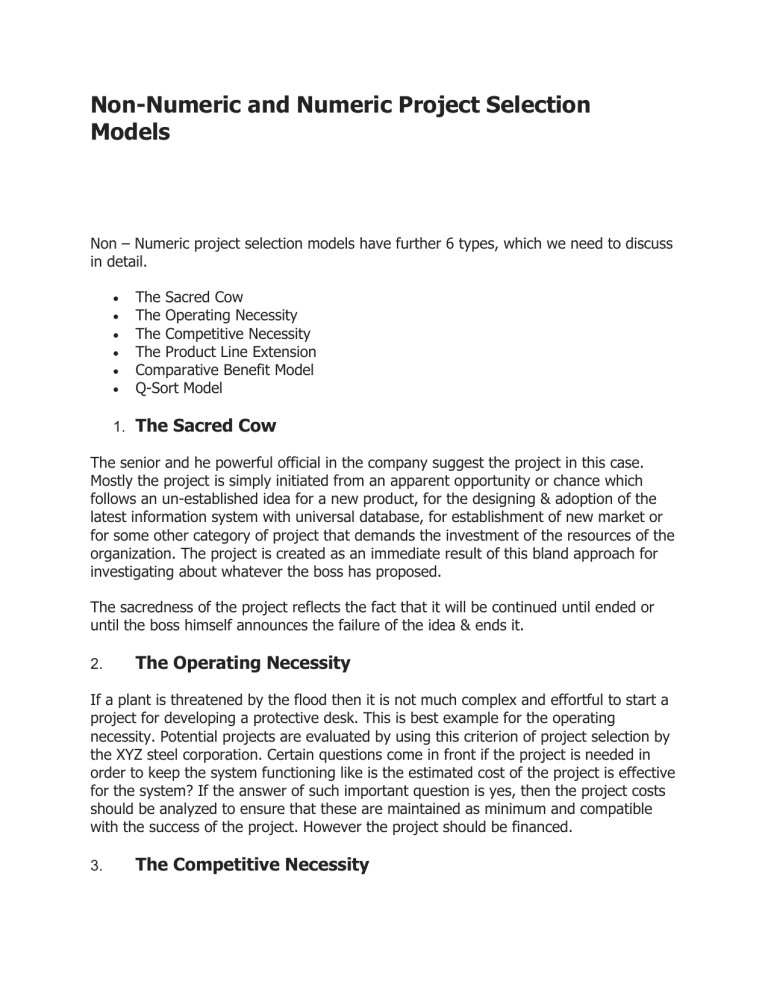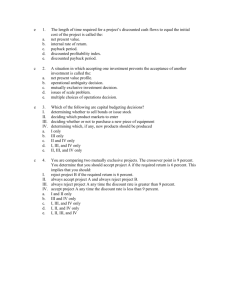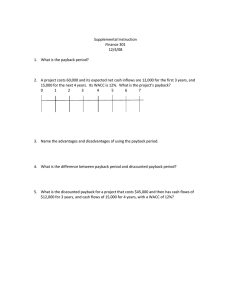
Non-Numeric and Numeric Project Selection Models Non – Numeric project selection models have further 6 types, which we need to discuss in detail. The Sacred Cow The Operating Necessity The Competitive Necessity The Product Line Extension Comparative Benefit Model Q-Sort Model 1. The Sacred Cow The senior and he powerful official in the company suggest the project in this case. Mostly the project is simply initiated from an apparent opportunity or chance which follows an un-established idea for a new product, for the designing & adoption of the latest information system with universal database, for establishment of new market or for some other category of project that demands the investment of the resources of the organization. The project is created as an immediate result of this bland approach for investigating about whatever the boss has proposed. The sacredness of the project reflects the fact that it will be continued until ended or until the boss himself announces the failure of the idea & ends it. 2. The Operating Necessity If a plant is threatened by the flood then it is not much complex and effortful to start a project for developing a protective desk. This is best example for the operating necessity. Potential projects are evaluated by using this criterion of project selection by the XYZ steel corporation. Certain questions come in front if the project is needed in order to keep the system functioning like is the estimated cost of the project is effective for the system? If the answer of such important question is yes, then the project costs should be analyzed to ensure that these are maintained as minimum and compatible with the success of the project. However the project should be financed. 3. The Competitive Necessity In the late 1960’s, XYZ Steel considered an important plant rebuilding project by using this criterion in its steel bar producing facilities near Chicago. It was clear to the management of the company that certain modernization is required in its bar mill in order to keep the current competitive position in the market area of Chicago. Perhaps the project has modern planning process, the desire to keep the competitive position of the company in the market provide basis for making such decision to carry on the project. Similarly certain undergraduate and Master in Business Administration (MBA) programs are restructured in the offerings of many universities to keep their competitive position in the academic market. Precedence is taken by the operating necessity projects over competitive necessity projects regarding investment. But both of these types of project selection models are considered much useful & effective as compared to other selection models. 4. The Product Line Extension In case of the product line extension, a project considered for development & distribution of new products will be evaluated on the basis of the extent to which it suits the company’s current product lines, fortify a weak line, fills a gap, or enhanced the line in a new & desirable direction. In certain cases careful evaluations of profitability is not needed. The decision makers can perform actions on the basis of their belief about the probable influence of the addition of the new product to the line over the entire performance of system. 5. Comparative Benefit Model According to this selection model, there are several projects that are being considered by the organization. Those subset of the projects are selected by the senior management of the organization can provide most benefits to the company. But comparing various projects is not an easy task. For example some projects are related to the new products, some are related to the computerization of particular records, others are related to make alteration in the method of production and some of them may contain such area that cannot be easily categorized. There is no formal method of selection of projects in the organization but it is the perception of the selection committee members that certain projects will benefit the company more than the others even they lack the suitable way to specify or measure the proposed benefit. For all sort of projects, if not a formal model, the concept of comparative benefits is enormously used for selection decisions. United States Companies considering various social programs for providing funds to them use this concept to make the decisions. All the considered projects with positive recommendations are examined by the senior management of the funding organization in order to make effort to develop a portfolio that can effectively suits the objectives & budgets of the organization. 6. Q-Sort Model The Q-Sort model is the one of the most straightforward techniques for ordering projects. According to their relative merits, the projects are first divided into three groups which are Good, Fair and Poor. The main group is further subdivided into the two types of fair-minus and fair-plus if any group has the has more than eight members. The projects within each type are ranked from best to worst when all types have eight or fewer members. Again relative merit provides the basis for determining the order. Specific criterion is used by the rater to rank each project or he may merely use general entire judgment. Q-Sort Model Example One person has the responsibility to carry out the process for evaluation & selection of the project. In certain cases there is a selection committee for performing such process. If the task is handled by the committee, individual ranking can be build anonymously and the committee examines the set of anonymous ranking for consensus. These ranking differ from to some degree from rater to rater but that difference is not much enhanced because the selected individuals for such committees seldom differ increasingly on their consideration for the suitability for the parent organization. Finally the projects are selected on sequence of preference, though they are generally assessed on financial basis before final selection. There are certain other non-numeric models for rejecting or accepting projects. Numeric Project Selection Models (Profit/Profitability) The profitability is used as the only measure of acceptability by majority of organizations using different types of project selection models. Following are some of numeric models for project selection. Payback Period Average Rate of Return Discounted Cash Flow Internal Rate of Return (IRR) Profitability Index Other Profitability Models 1. Payback Period The initial fixed investment in the project divided by the forecasted annual net cash inflows from the project is referred to as payback period for the project. The number of years needed by the project to refund its initial fixed investment is reflected in the ratio of these quantities. For example suppose a project costs $200,000 to operate and has annual net cash inflows of $40,000. Then Payback Period = $200,000 / $40,000v = 5 Years This method suppose that the cash inflows will die hard to the minimum extent to pay back the investment, and any cash inflows outside the payback period are ignored. This method also functions as inadequate representative for the risk. The company faces less risk when it recovers the initial investment fast. 2. Average Rate of Return The ratio of the average annual profit (either after or before taxes) to the average or initial investment in the project is referred to as the average rate of return. It is mostly misunderstood as the reciprocal of payback period. The average rate of return does not generally equal the reciprocal of the payback period because average annual profits are generally not equivalent to the net cash inflows. In the above mentioned example, suppose the average annual profits are $30,000 Average Rate of Return = $30,000 / $200,000 = 0.15 None of the two above mentioned evaluation methods are effective for project selection, though payback period is frequently used and exhibits reasonable value for decisions related to cash budgeting. These two models have major advantage in the shape of simplicity, but none of them cover the important concept of time value of money. 3. Discounted Cash Flow Discounted cash flow method is also called Net Present Value (NPV) method. The net present value of all cash flows is determined by discounting them by the required rate of return in this method. Where k = the required rate of return, Ft = the net cash flow in period t and Ao = the initial cash investment In order to cover the affect of inflation in the equation Where, pt is the forecasted rate of inflation during the period t. Net cash flow is likely to be negative in the early life of the project because of the potential outflow in the form of initial investment. However cash flow will become positive when the project acquires the success. If the sum of the net present value of net present value of all forecasted cash flows throughout the life of the project is positive, the project is acceptable. A simple example will be adequate. Suppose a project has initial investment of $100,000. It has net cash inflow of $25,000 per year for a period of eight years. The required rate of return for the project is 15% with an inflation rate of 3% p.a. Now the NPV of this project is calculated as below The Net Present Value of the project is positive because the present value of the inflows is higher than the present value of the outflows. So this should be acceptable. 4. Internal Rate of Return (IRR) If there are two sets expected cash flows, one for expected cash inflows and other for expected cash outflows then Internal Rate of Return is the discount rate that equalizes the present value of the two sets of flows. If Rt is the forecasted cash inflow for period t and At is a forecasted cash outflow in the period t, the internal rate of return is the value of k that satisfies the following equation The value of k is ascertained by trial & error. 5. Profitability Index The net present value of all future expected cash flows divided by the initial investment is referred to as profitability index. Profitability index is also called the benefit-cost ratio. The project may be accepted, if this ratio is higher than 1.0. 6. Other Profitability Models The models just explained have different variations that fall into the following three groups 1. Those that further split the net cash flow into components that make up the net flow 2. Those that contain particular terms to acquaint risk (uncertainty) into the assessment 3. Those that widen the analysis to view impacts that the project can have on activities or projects in the company




